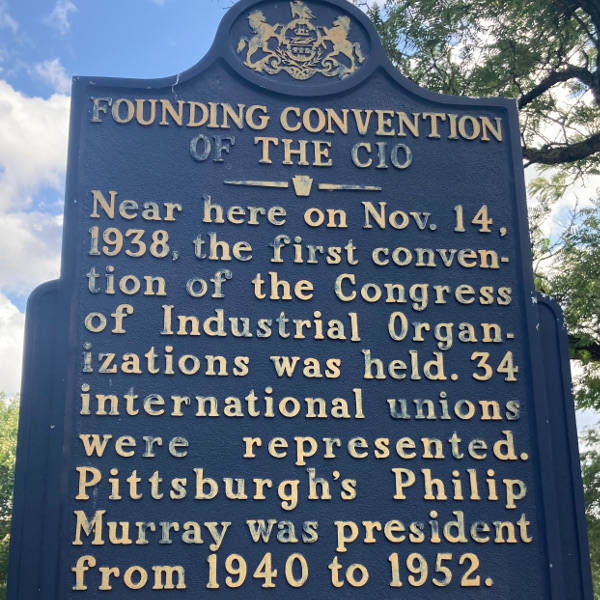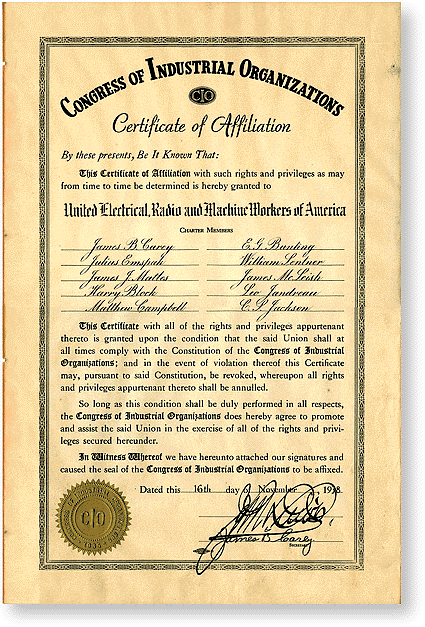
Historical marker in Pittsburgh’s Northside neighborhood.
Eight-five years ago today, the founding convention of the Congress of Industrial Organizations (CIO) opened in Pittsburgh. For years, new types of workers — workers in the mass-production industries long deemed “unorganizable” by many in the American Federation of Labor (AFL) — had been organizing new unions, often independently of the conservative craft unions that dominated the AFL. Like today, many of these struggles were led by young workers.
The CIO had initially been formed in 1935 as the “Committee for Industrial Organization” by labor leaders who understood that the labor movement had to organize these workers, and to do it on an industrial basis, uniting all workers in an industry rather than dividing them up by craft.
They had also learned the lesson that unions need to organize and unite all workers, not only across divisions of craft but also those of race, gender, ethnicity and belief. Employers’ ability to successfully pit white and Black workers against each other during the Great Steel Strike of 1919 was one of the major reasons that strike was lost. Many industries, especially the electrical manufacturing industry, employed a large number of women — it would be impossible to organize without including them as full members of unions. Most industries employed immigrants from a wide variety of countries — much early CIO organizing was conducted in many languages.
One of the new unions being formed at the time was UE — founded in 1936 by a group of independent unions in electrical and radio plants who declared in the preamble of their new constitution their intention to “form an organization which unites all workers on an industrial basis, and rank-and-file control, regardless of craft, age, sex, nationality, race, creed, or political beliefs, and pursue at all times a policy of aggressive struggle to improve our conditions.” At their founding convention, they elected young workers as their leaders: the 24-year-old James Carey as President and 30-year-old Julius Emspak as Secretary-Treasurer. In 1937 the 28-year-old James Matles would join them as the union’s first Director of Organization.

UE was the first union chartered by the CIO.
The refusal of the AFL to grant a charter to UE was one of the key issues that led CIO leaders to break from the AFL and found their own federation. Thirty-seven different AFL unions claimed jurisdiction over UE plants — and many of them had constitutions which limited membership on the basis of age, sex, race, religion, political belief, and even the state of a worker’s health.
As the UE NEWS noted in a recent feature, Pittsburgh was a fitting place for the CIO’s founding convention:
[T]he inability of the AFL’s craft unions to organize the industries of Pittsburgh — its steel mills but also its massive electrical plants — was invoked by Mineworkers’ President John L. Lewis at the founding convention ... as Lewis pointed out in his address to the new federation’s founding convention, CIO unions like the Steelworkers and UE had succeeded in a few short years in turning Pittsburgh from a bastion of anti-unionism into one of the strongest union towns in the country.
Over the following decade, CIO unions would lead struggles that brought an unprecedented level of prosperity and security to large swaths of the U.S. working class, and the unionization rate in the U.S. to its highest point. Jack Metzgar, who grew up in a steelworker household in Western Pennsylvania, wrote in his memoir, “If what we lived through in the 1950s was not liberation, then liberation never happens in real human lives.”
The CIO would begin to abandon its founding principles in 1949 and 1950, when it expelled eleven unions including UE and the ILWU, and would merge with the AFL in 1955. However, the old principles of CIO unionism, kept alive by UE, ILWU, and countless rank-and-file activists throughout the labor movement, are on display in today’s labor movement more than ever in recent memory — especially in the recent successful “stand-up strike” led by the UAW, once the CIO’s largest union.
